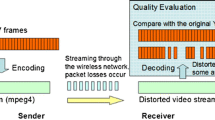Abstract
The objective of this paper is to demonstrate the advantages of using hysteresial techniques in flow control mechanisms. The work scenario consists of a server transmitting video information to a group of clients. Each client stores the information in a buffer and then plays it back at a set consumption rate. To avoid “overflow” or “underflow” in the buffer, the client sends control messages (feedbacks) to the server which order adjustments in the transmission rate. Hysteresial techniques allow the minimization of this signaling traffic, even when there are rapid fluctuations in the buffer occupation. As a first step, an analytical model is developed using Markovian processes. This produces expressions of the most relevant parameters and allows the evaluation of the proposed flow control mechanism. The Markovian model has been compared with the performance of a multimedia application for video distribution, running in a real scenario. The results show that the model represents qualitatively the real scenario and consequently validates the model usefulness.
Similar content being viewed by others
References
J.C. Bolot and T. Turletti, “A rate control mechanism for a packet video in the internet,” in Proc. IEEE INFOCOM'94, Toronto, June 1994, pp. 1216–1223.
V. Casares, “Variable bit rate voice using hysteresis thresholds,” submitted for publication.
M. Esteve, C. Palau, and J.C. Guerri, “A synchronization service framework for XTP,” in Proc. 20th Annual Conference on Local Computer Networks, Minneapolis, Oct. 1995, pp. 209–218.
J.F. Gibbon and T.D.C. Little, “The use of network delay estimation for multimedia data retrieval,” IEEE Journal on Selected Areas in Communications, Vol. 14, No. 7, pp. 1376–1387, 1996.
J.C. Guerri, C. Palau, and M. Esteve, “Feedback-global protocol and the web: Framework and performance,” in Proc. W3C Workshop Real-Time Multimedia and the World Wide Web, Sophia-Antipolis, France, Oct. 1996. Paper 6.
J.Y. Hui, E. Karasan, J. Li, and J. Zhang, “Client server synchronization and buffering for variable rate multimedia retrievals,“ IEEE Journal on Selected Areas in Communications, Vol. 14, No. 1, pp. 226–237, 1996.
S. Jacobs and A. Eleftheriadis, “Providing video services without quality of service guarantees,” in Proc. W3C Workshop Real Time Multimedia and the World Wide Web, Sophia-Antipolis, France, Oct. 1996. Paper 20.
J. King, Computer and Communication Systems Performance Modeling, Prentice Hall, New York, 1990.
L. Kleinrock, Queueing Systems, Vol. 1, John Wiley, New York, 1975.
H. Kopetz and W. Ochsenreiter, “Clock synchronization in distributed real-time systems,” IEEE Transactions on Computer C-38, pp. 933–939, 1987.
T.D.C. Little and A. Ghafoor, “Multimedia synchronization protocols for broadband integrated services,” IEEE Journal on Selected Areas in Communications, Vol. 9, No. 9, pp. 1368–1382, 1991.
D. Mills, “Internet time protocol: The network protocol,” IEEE Transactions on Communications, Vol. 39, No. 10, pp. 1482–1493, 1991.
S. Ramanathan and V. Rangan, “Adaptative feedback techniques for synchronized multimedia retrieval over integrated networks,” IEEE/ACM Transactions on Networking, Vol. 1, No. 2, pp. 246–259, 1993.
V. Rangan and S. Ramanathan, “Designing an on-demand multimedia service,” IEEE Communications Magazine, pp. 56–64, 1992.
S. Ross, Stochastic Process, John Wiley, New York, 1996.
R. Steinmetz, “Synchronization properties in multimedia systems,” IEEE Journal on Selected Areas in Communications, Vol. 8, No. 3, pp. 401–411, 1990.
R. Steinmetz, “Human perception of Jitter and media synchronization,” IEEE Journal on Selected Areas in Communications, Vol. 14, No. 1, pp. 61–72, 1996.
R. Steinmetz and K. Nahrstedt, Multimedia: Computing, Communications, and Applications, Prentice Hall, Upper Saddle River, NJ, 1995.
Author information
Authors and Affiliations
Rights and permissions
About this article
Cite this article
Guerri, J.C., Esteve, M., Palau, C. et al. Feedback Flow Control with Hysteresial Techniques for Multimedia Retrievals. Multimedia Tools and Applications 13, 307–332 (2001). https://doi.org/10.1023/A:1009633314583
Issue Date:
DOI: https://doi.org/10.1023/A:1009633314583




